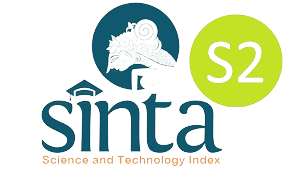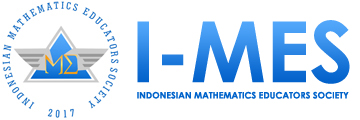Integrating virtual reality and problem-based learning in STEM education: A contextual approach to enhance mathematical literacy through cultural heritage
DOI:
https://doi.org/10.29408/jel.v11i3.29894Keywords:
mathematical literacy, problem-based learning, STEM, virtual realityAbstract
Mathematical literacy is an essential competency in mathematics education that plays a crucial role in equipping students to meet the demands of the 21st century. However, students' mathematical literacy in Indonesia remains low. This study aimed to investigate how problem-based learning (PBL) with virtual reality (VR) technology in STEM education, contextualised within the complex of Arjuna Temple in Dieng, could be designed to enhance mathematical literacy. The study employed a design research method involving tenth-grade students at a senior high school in Wonosobo, Indonesia. Qualitative techniques were used to analyse students' responses to the implemented learning, while quantitative techniques were applied to analyse students' pretest and posttest results. The study produced a learning design validated by three experts and deemed practical by five practitioners. The results indicated a significant improvement in students' pre- and post-test scores. Students also provided positive feedback regarding the developed learning program. Given these results, Problem-Based Learning with Virtual Reality STEM education technology contextualised to the Arjuna Dieng Temple complex was considered a viable approach to enhancing mathematical literacy.
References
Agustiani, S., Agustiani, N., & Nurcahyono, N. A. (2021). Analisis berpikir literasi matematika berdasarkan kemandirian belajar siswa SMP [analysis of mathematical literacy thinking based on the learning independence of junior high school students]. EQUALS: Jurnal Ilmiah Pendidikan Matematika, 4(2), 67–78. https://doi.org/10.46918/equals.v4i2.966
Amalia, N., Pertiwi, C. M., & Amelia, R. (2022). Analisis kebutuhan bahan ajar lembar kerja siswa pelajaran matematika berbantuan ICT pada tingkat SMA [the analysis of the need for ICT-assisted student worksheet teaching materials in high school mathematics was conducted]. JPMI: Jurnal Pembelajaran Matematika Inovatif, 5(3), 711–722. https://doi.org/10.22460/jpmi.v5i3.711-722
Baherimoghadam, T., Hamedani, S., Mehrabi, M., Naseri, N., & Marzban, N. (2021). The effect of learning style and general self-efficacy on satisfaction of e-learning in dental students. BMC Medical Education, 21(1), 1–7. https://doi.org/10.1186/s12909-021-02903-5
Bakker, A. (2018). Design research in education: A practical guide for early career researchers. In Routledge Taylor & Francis Group. Routledge. https://doi.org/10.1049/ic:19990398
Buchori, A., & Rahmawati, N. D. (2024). Design of virtual reality-based mathematics virtual lab with constructivist approach in senior high school. International Conference on Digital Education and Social Science (ICDESS), December, 1–7.
Cahyono, A. N. (2024). VR STEM Trail: A math trail-based 9 stem education using virtual reality technology for learning mathematical modelling. In Augmented and virtual reality in mathematics education international symposium on augmented and virtual reality 2022 (pp. 151–163). Wiesbaden: Springer Spektrum. https://doi.org/10.1007/978-3-658-45271-1_9
Çakıroğlu, Ü., Güler, M., Dündar, M., & Coşkun, F. (2024). Virtual reality in realistic mathematics education to develop mathematical literacy skills. International Journal of Human–Computer Interaction, 40(17), 4661–4673. https://doi.org/10.1080/10447318.2023.2219960
Christopoulos, A., Pellas, N., & Laakso, M. (2020). A learning analytics theoretical framework for stem education virtual reality aplicationa. Education Sciences, 10(317), 1–15. https://doi.org/10.3390/educsci10110317
Dare, E. A., Keratithamkul, K., Hiwatig, B. M., & Li, F. (2021). Beyond content: The role of stem disciplines, real-world problems, 21st century skills, and stem careers within science teachers’ conceptions of integrated stem education. Education Sciences, 11(11), 737. https://doi.org/10.3390/educsci11110737
Dewi, N. R., & Maulida, N. F. (2023). The development of STEM-nuanced mathematics teaching materials to enhance students’ mathematical literacy ability through information and communication technology-assisted preprospec learning model. International Journal of Educational Methodology, 9(2), 409–421. https://doi.org/10.12973/IJEM.9.2.409
Fernandes, M., & Syarifuddin, H. (2020). Pengembangan perangkat pembelajaran pecahan berbasis model penemuan terbimbing untuk kelas IV SD [The development of a learning device on fractions based on the guided discovery model for fourth-grade elementary school students was carried out]. ELSE (Elementary School Education Journal) : Jurnal Pendidikan dan Pembelajaran Sekolah Dasar, 4(1), 20–35. https://doi.org/10.30651/else.v4i1.4011
Forde, E. N., Robinson, L., Ellis, J. A., & Dare, E. A. (2023). Investigating the presence of mathematics and the levels of cognitively demanding mathematical tasks in integrated STEM units. Disciplinary and Interdisciplinary Science Education Research, 5(1), 1–18. https://doi.org/10.1186/s43031-022-00070-1
Gündüzalp, S. (2021). 21 st century skills for sustainable education: prediction level of teachers’ information literacy skills on their digital literacy skills. Discourse and Communication for Sustainable Education, 12(1), 85–101. https://doi.org/10.2478/dcse-2021-0007
Hacioglu, Y., & Gulhan, F. (2021). The effects of stem education on the 7th grade students’ critical thinking skills and STEM perceptions. Journal of Education in Science, Environment and Health, 7(2), 139–155. https://doi.org/10.21891/jeseh.771331
Hamidah, I., Ilma, R., Putri, I., & Pramuditya, S. A. (2024). How is the implementation of realistic mathematics education on mathematical literacy skills? A systematic literature review. Mosharafa: Jurnal Pendidikan Matematika, 13(3), 741–756.
Harefa, D., & Suastra, I. W. (2024). Mathematics education based on local wisdom: Learning strategies through hombo batu. AFORE: Jurnal Pendidikan Matematika, 3(2), 1–11.
Juandi, D. (2021). Heterogeneity of problem-based learning outcomes for improving mathematical competence: A systematic literature review. Journal of Physics: Conference Series, 1722(1), 1–7, 012108. https://doi.org/10.1088/1742-6596/1722/1/012108
Kelana, J. B., Wardani, D. S., Firdaus, A. R., Altaftazani, D. H., & Rahayu, G. D. S. (2020). The effect of STEM approach on the mathematics literacy ability of elementary school teacher education students. Journal of Physics: Conference Series, 1657(1), 012006. https://doi.org/10.1088/1742-6596/1657/1/012006
Khairani, S., Suyanti, R. D., & Saragi, D. (2020). The influence of problem based learning (PBL) model collaborative and learning motivation based on students’ critical thinking ability science subjects in class v state elementary school 105390 island image. Budapest International Research and Critics in Linguistics and Education (BirLE) Journal, 3(3), 1581–1590. https://doi.org/10.33258/birle.v3i3.1247
Kusuma, A. C., Ekasari, S. R., & Weddakarti, E. (2022). Implementation of interactive mathematics teaching e-modul to improve student motivation and learning outcomes. Hipotenusa : Journal of Mathematical Society, 4(1), 1–12. https://doi.org/10.18326/hipotenusa.v4i1.7218
Mania, S., & Alam, S. (2021). Teachers’ perception toward the use of ethnomathematics approach in teaching math. International Journal of Education in Mathematics, Science and Technology, 9(2), 282–298. https://doi.org/10.46328/IJEMST.1551
Marougkas, A., Troussas, C., Krouska, A., & Sgouropoulou, C. (2023). Virtual reality in education: A review of learning theories, approaches and methodologies for the last decade. Electronics (Switzerland), 12(13), 2832. https://doi.org/10.3390/electronics12132832
Maslihah, S., Waluya, S. B., Rochmad, Kartono, Karomah, N., & Iqbal, K. (2021). Increasing mathematical literacy ability and learning independence through problem-based learning model with realistic mathematic education approach. Journal of Physics: Conference Series, 1918(4), 042123. https://doi.org/10.1088/1742-6596/1918/4/042123
Nugroho, M. A., Yulandari, I., & Cahyono, A. N. (2024). Project-based learning through augmented reality-assisted math trails at Blenduk Church to promote mathematical literacy. Jurnal Elemen, 10(2), 363–377. https://doi.org/10.29408/jel.v10i2.25333
Nurfadhillah, S., Ulfah, M., Nikmah, S. Z., & Fitriyani, D. (2021). Peranan media pembelajaran dalam meningkatkan minat siswa serta memotivasi belajar siswa kelas 3 SDN Kohod III [the role of learning media in increasing students’ interest and motivating the learning of third-grade students at SDN Kohod III]. BINTANG: Jurnal Pendidikan Dan Sains, 3(2), 260–271.
Nurva, M. S., Fikriani, T., & Yuni, R. T. (2022). Pengembangan soal tipe HOTS (high order thingking skills) terhadap kemampuan literasi matematis siswa kelas XII SMA [the development of HOTS (higher order thinking skills) questions was aimed at enhancing the mathematical literacy skills of twelfth-grade . Integral: Jurnal Penelitian Pendidikan Matematika Pengembangan, 5(1), 15–20. https://doi.org/10.24905/jppm.v5i1.98
OECD. (2023). PISA 2022 result (volume 1): The state of learning and equity in education: Vol. 1. OECD Publishing.
Pathuddin, H., & Nawawi, M. I. (2021). Buginese ethnomathematics : Barongko cake. Journal on Mathematics Education, 12(2), 295–312.
Pratama, M. A. (2020). Mathematical critical thinking ability and students’ confidence in mathematical literacy. Journal of Physics: Conference Series, 1663(1), 012028. https://doi.org/10.1088/1742-6596/1663/1/012028
Ruiz-Rojas, L. I., Acosta-Vargas, P., De-Moreta-Llovet, J., & Gonzalez-Rodriguez, M. (2023). Empowering education with generative artificial intelligence tools: Approach with an instructional design matrix. Sustainability (Switzerland), 15(15), 11524. https://doi.org/10.3390/su151511524
Situmorang, R. O. (2024). Pengaruh pembelajaran berbasis proyek terhadap kemampuan berpikir kreativ matematis siswa kelas VIII [the influence of project-based learning on the mathematical creative thinking ability of eighth-grade students]. Journal of Education Research, 5(4), 4335–4341. https://doi.org/10.37985/jer.v5i4.1621
Sujatha, S., & Vinayakan, K. (2022). Mathematical literacy for the future : A review of emerging curriculum and instructional trends. International Journal of Applied and Advanced Scientific Research (IJAASR), 7(2), 65–71.
Syafitri, A., Huda, N., & Haryanto, H. (2021). Problem-based learning model: It’s effect on mathematical literacy ability based on students’ visual verbal ability. Al-Jabar: Jurnal Pendidikan Matematika, 12(2), 427–436. https://doi.org/10.24042/ajpm.v12i2.10366
Tabun, H. M., Taneo, P. N. L., & Daniel, F. (2020). Kemampuan literasi matematis siswa pada pembelajaran model problem based learning (PBL) [students’ mathematical literacy skills in learning using the problem-based learning (PBL) model]. Edumatica: Jurnal Pendidikan Matematika, 10(01), 1–8. https://doi.org/10.22437/edumatica.v10i01.8796
Tambunan, T. D. A., & Mukhtar. (2023). Penerapan model pembelajaran problem based learning berbantuan geogebra untuk meningkatkan kemampuan literasi matematis siswa kelas X SMA negeri 4 Medan [The implementation of the problem-based learning model assisted by geogebra was carried out to improv. Journal of Student Research (JSR), 1(3), 75–98. https://doi.org/10.55606/jsr.v1i3.1260
Tanjung, H. S., & Nababan, S. A. (2018). Pengembangan perangkat pembelajaran matematika berorientasi model pembelajaran berbasis masalah (PBM) untuk meningkatkan kemampuan berpikir kritis siswa SMA se-Kuala Nagan Raya Aceh [The development of mathematics learning tools oriented toward the proble. Genta Mulia, 9(2), 56–70.
UNESCO. (2017). Education for sustainable development goals: Learning objectives. In Education for Sustainable Development Goals: learning objectives. https://doi.org/10.54675/cgba9153
Üredi, P., & Doğanay, A. (2023). Developing the skill of associating mathematics with real life through realistic mathematics education: An action research. Kuramsal Eğitimbilim, 16(2), 394–422. https://doi.org/10.30831/akukeg.1214339
Wan, Z. H., Jiang, Y., & Zhan, Y. (2020). STEM education in early childhood: A review of empirical studies. Early Education and Development, 32(7), 940–962. https://doi.org/10.1080/10409289.2020.1814986
Yasin, M., & Novaliyosi, N. (2023). Systematic literature review: Integrasi model problem based learning dengan media pembelajaran dalam peningkatan kemampuan pemecahan masalah [Systematic literature review: the integration of the problem-based learning model with learning media in enhancin. Jurnal Lebesgue: Jurnal Ilmiah Pendidikan Matematika, Matematika dan Statistika, 4(2), 728–747. https://doi.org/10.46306/lb.v4i2.323
Downloads
Published
How to Cite
Issue
Section
License
Copyright (c) 2025 Munzid Mahendra, Nanik Asriyah Ismawati, Adi Nur Cahyono

This work is licensed under a Creative Commons Attribution-ShareAlike 4.0 International License.
Authors who publish with the Jurnal Elemen agree to the following terms:
- Authors retain copyright and grant the journal right of first publication with the work simultaneously licensed under Creative Commons Attribution-ShareAlike 4.0 International License (CC BY-SA 4.0).
- Authors are able to enter into separate, additional contractual arrangements for the distribution of the journal's published version of the work (e.g., post it to an institutional repository or publish it in a book), with an acknowledgment of its initial publication in this journal.
- Authors are permitted and encouraged to post their work online (e.g., in institutional repositories or on their website) prior to and during the submission process, as it can lead to productive exchanges, as well as earlier and greater citation of published work.
Jurnal Elemen is licensed under a Creative Commons Attribution-ShareAlike 4.0 International License





